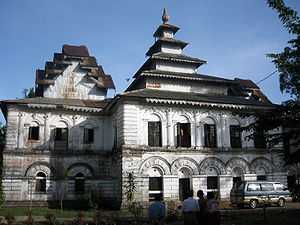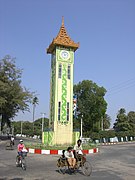Sittwe
| Sittwe စစ်တွေမြို့ | |
|---|---|
|
Sittwe main street | |
 Sittwe Location in Burma | |
| Coordinates: 20°09′00″N 92°54′00″E / 20.15000°N 92.90000°E | |
| Country |
|
| Division | Rakhine State |
| District | Sittwe District |
| Township | Sittwe Township |
| Population (2006) | |
| • Total | 181,000 |
| • Ethnicities | Rakhine |
| • Religions | Buddhism, |
| Time zone | MST (UTC+6.30) |
| Area code(s) | 42, 43 |
| [1] | |
Sittwe (Burmese: စစ်တွေမြို့; MLCTS: cac twe mrui.; Burmese pronunciation: [sɪʔtwè mjo̰]; formerly, Akyab) is the capital of Rakhine State, Myanmar (Burma). Sittwe, pronounced site-tway in the Rakhine language, is located on an estuarial island created at the confluence of the Kaladan, Mayu, and Lay Mro rivers emptying into the Bay of Bengal. The city has 181,000 inhabitants (2006). it is the administrative seat of Sittwe Township and Sittwe District.
Etymology
The name Sittwe is the Burmese version of Rakhine Saite-Twêy (literally, "the place where the war meets"). When the Burmese King Bodawpaya invaded the Mrauk-U Kingdom in 1784, the Rakhine defenders encountered the Burmese force at the mouth of Kalandan river. In the ensuing battle, which was waged on both land and water, the Mrauk-U forces were defeated. The place where the battle occurred came to be called Site Twêy by the Rakhine, and colloquially as Sittwe by the Burmese.
In early 1825, during the First Anglo-Burmese War, the British forces landed at Sittwe and stationed their forces by the ancient pagoda, Ahkyaib-daw, which is still standing at the head of the city. The British adopted the name Akyab for the place.
History
Originally a small fishing village, Sittwe became an important seat of maritime commerce, especially as a port for the export of rice after the British occupation of Arakan, now known as Rakhine State, following the First Anglo-Burmese War.
Sittwe was the location of a battle during the conquest of Arakan by the Burmese king Bodawpaya. In 1784, the Burmese expeditionary force, some 30,000 strong, encountered the governor of U-rit-taung Province, Saite-ké (General) Aung and his force of 3000.[2] Outnumbered hugely, the Arakanese force tried to fight the Burmese forces on both land and sea, but were brutally crushed. This defeat opened the route towards the inland Arakanese capital of Mrauk-U, which was soon conquered, ending the independence of the Arakanese. According to Arakanese lore, all of the Arakanese defenders were killed.
In 1826, after the First Anglo-Burmese War, the British transferred the seat of government from to Sittwe on the seacoast. During the first 40 years of British rule it increased from a village to a town of 15,536 inhabitants, and by 1901 it was the third port of Burma with a population of 31,687. During colonial times, Site-tway had a bad reputation for malaria and cholera, although historical records indicate that it was no better or worse than many other locations along the India coast.
During World War II the island was an important site of many battles during the Burma Campaign due to its possession of both an airfield and a deepwater port.
Sittwe is the birthplace of political monks in Myanmar. It was the birthplace of U Ottama, the first monk who protested against the colonial British in Myanmar. Also, in the recent 2007 riots, it was the monks in Sittwe who started the protest against the Military Government in Myanmar.
Sittwe houses the Dhanyawadi Naval Base, named after the ancient Rakhine city-state of Dhanyawadi.
Demographics
The largest ethnic group in Sittwe is the Rakhine people. Alongside, there are some Burmese from other parts of the country. The vast majority practices Theravada Buddhism, Hinduism or Animism. The Muslim quarter used to be called Aung Mingala, until the Muslims were driven out during the 2012 riots in October.[3]
There was a tension between Rakhine and Muslims started with dispute on contracted taxation of a market in May-Jun 2012. A Rakhine mob tried to besieged a Sittwe police station. Police crushed down with gun fires and at least 10 people were hurt and 9 people were detained.[4]
Attractions
- Viewpoint, or more popularly known as Point is perhaps the most well known attraction in Sittwe. It is at the end of the Strand Road and looks out into the Bay of Bengal and the mouth of the Kaladan River.
- The hundred year old Shwe Zedi Kyaung is a famous monastery in Sittwe. It was the monastery of U Ottama, who was the first political monk in Myanmar.
- Pyay-Lone-Chan-Thar Pharagri, the focal point of Sittwe's Buddhist environment, beside Shwe Zedi Kyaung.
- Ahkyaib-daw, is one of the most sacred Buddhist pagodas, believed to have built in the days of Emperor Asoka (r. 269-232 BCE). The pagoda Ahkyaib-daw, meaning maxillary bone, is believed to be built on a foundation encasing a piece of Buddha’s maxillary bone hence its name.[5]
- Rakhine State Cultural Museum, which contains exhibits on Rakhine culture and history.
Climate
Sittwe's climate is classified as a tropical monsoon climate (Am), according to the Köppen climate classification system. The city experiences a dry season from December through April, and an extraordinarily rainy wet season covering the remaining seven months. Sittwe sees average rainfall in excess of 1 metre (40 in) per month during June, July and August. Conditions are noticeably cooler and less humid in the months of December, January and February than during the remainder of the year.
| Climate data for Sittwe | |||||||||||||
|---|---|---|---|---|---|---|---|---|---|---|---|---|---|
| Month | Jan | Feb | Mar | Apr | May | Jun | Jul | Aug | Sep | Oct | Nov | Dec | Year |
| Average high °C (°F) | 28.0 (82.4) |
29.4 (84.9) |
31.4 (88.5) |
34.1 (93.4) |
31.5 (88.7) |
29.5 (85.1) |
28.9 (84) |
28.9 (84) |
30.1 (86.2) |
31.1 (88) |
30.3 (86.5) |
28.5 (83.3) |
30.14 (86.25) |
| Average low °C (°F) | 14.7 (58.5) |
15.9 (60.6) |
18.2 (64.8) |
23.6 (74.5) |
25.1 (77.2) |
24.6 (76.3) |
24.7 (76.5) |
24.5 (76.1) |
24.6 (76.3) |
24.0 (75.2) |
21.0 (69.8) |
16.6 (61.9) |
21.46 (70.63) |
| Average precipitation mm (inches) | 11 (0.43) |
8 (0.31) |
5 (0.2) |
44 (1.73) |
268 (10.55) |
1,091 (42.95) |
1,155 (45.47) |
1,025 (40.35) |
537 (21.14) |
289 (11.38) |
105 (4.13) |
17 (0.67) |
4,555 (179.31) |
| Avg. rainy days | 0 | 0 | 0 | 3 | 13 | 23 | 25 | 25 | 18 | 10 | 4 | 0 | 121 |
| Mean monthly sunshine hours | 279 | 252 | 279 | 240 | 186 | 120 | 93 | 93 | 120 | 186 | 240 | 248 | 2,336 |
| Source #1: HKO (1961-1990)[6] | |||||||||||||
| Source #2: World Climate Guide (rain days & sunshine, 1961-1990)[7] | |||||||||||||
Education
- Sittwe University
- Computer University, Sittwe
- Technological University, Sittwe
- Government Technological High School, Sittwe
Economy
In February 2007, India announced a plan to develop the port, which would enable ocean access from Indian Northeastern states, so called "Seven sisters", like Mizoram, via the Kaladan River.[8] Sittwe's citizenry, especially Buddhist monks, have participated in the 2007 Burmese anti-government protests
In October 2011, as part of a recent bilateral trade deal signed by Myanmar and India, the two countries pledged a U$120 Million port and multimodal investment to complete the infrastructure linking Indian Northeastern provinces to Sittwe port in Northwestern Myanmar, overland via India's Mizoram by 2013.
The port of Sittwe will undergo extensive dredging and the construction of new berthing terminals. Once operational it will offer direct sailings to enable Burmese and Indian shippers to pick up mainline services to and from Kolkata. The two countries also pledged to double bilateral trade to $3 billion by 2015 by reducing trade tariffs.
Other
British writer Hector Hugh Munro, better known under his pen name Saki, was born in Sittwe in 1870. A road in Singapore is named after its old name(Akyab)
Image gallery
-

Shwe Zedi Monastery
-
The main street
-
foreshore
-
new clock tower
See also
References
- ↑ "National Telephone Area Codes". Myanmar Yellow Pages.
- ↑ Shwe Lu Maung alias Shahnawaz Khan: The Price of Silence, A Muslim-Buddhist War of Bangladesh and Myanmar - A Social Darwinist's Analysis, DewDrop Arts & Technology, 2005
- ↑ http://www.economist.com/news/asia/21565638-why-buddhists-and-muslims-rakhine-state-myanmar-are-each-others%E2%80%99-throats-unforgiving
- ↑ http://www.washingtonpost.com/world/asia_pacific/govt-calls-for-calm-after-clashes-in-western-myanmar-kill-9-wound-a-dozen/2012/06/04/gJQApKN8CV_story.html
- ↑ Shwe Lu Maung alias Shahnawaz Khan, The Price of Silence: Muslim-Buddhist War of Bangladesh and Myanmar – A Social Darwinist’s Analysis, DewDrop Arts & Technology, 2005, p174.
- ↑ "Climatological Information for Sittwe, Myanmar". Hong Kong Observatory. Retrieved January 12, 2013.
- ↑ "Sittwe Climate Guide, Burma (Myanmar)". World Climate Guide. Retrieved January 12, 2013.
- ↑ India to develop Myanmar port to benefit northeast, Press Trust of India, February 3, 2007
| Wikimedia Commons has media related to Sittwe. |
External links
- MSN Map - elevation = 1m
- 20° 9' 0" North, 92° 54' 0" East Satellite map at Maplandia.com
- Kaladan.com - covering Kaladan project and news
| Sittwe | ||
| Preceded by None |
Capital of British Arakan 24 February 1826 – 31 January 1862 |
Succeeded by Yangon |
| |||||||||||||||||||||||||||||
Coordinates: 20°08′40″N 92°53′49″E / 20.14444°N 92.89694°E




